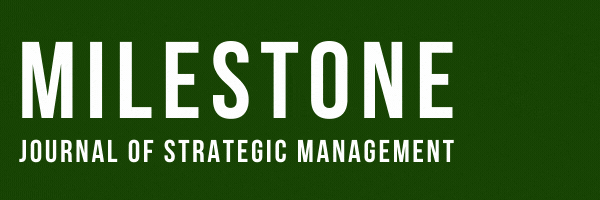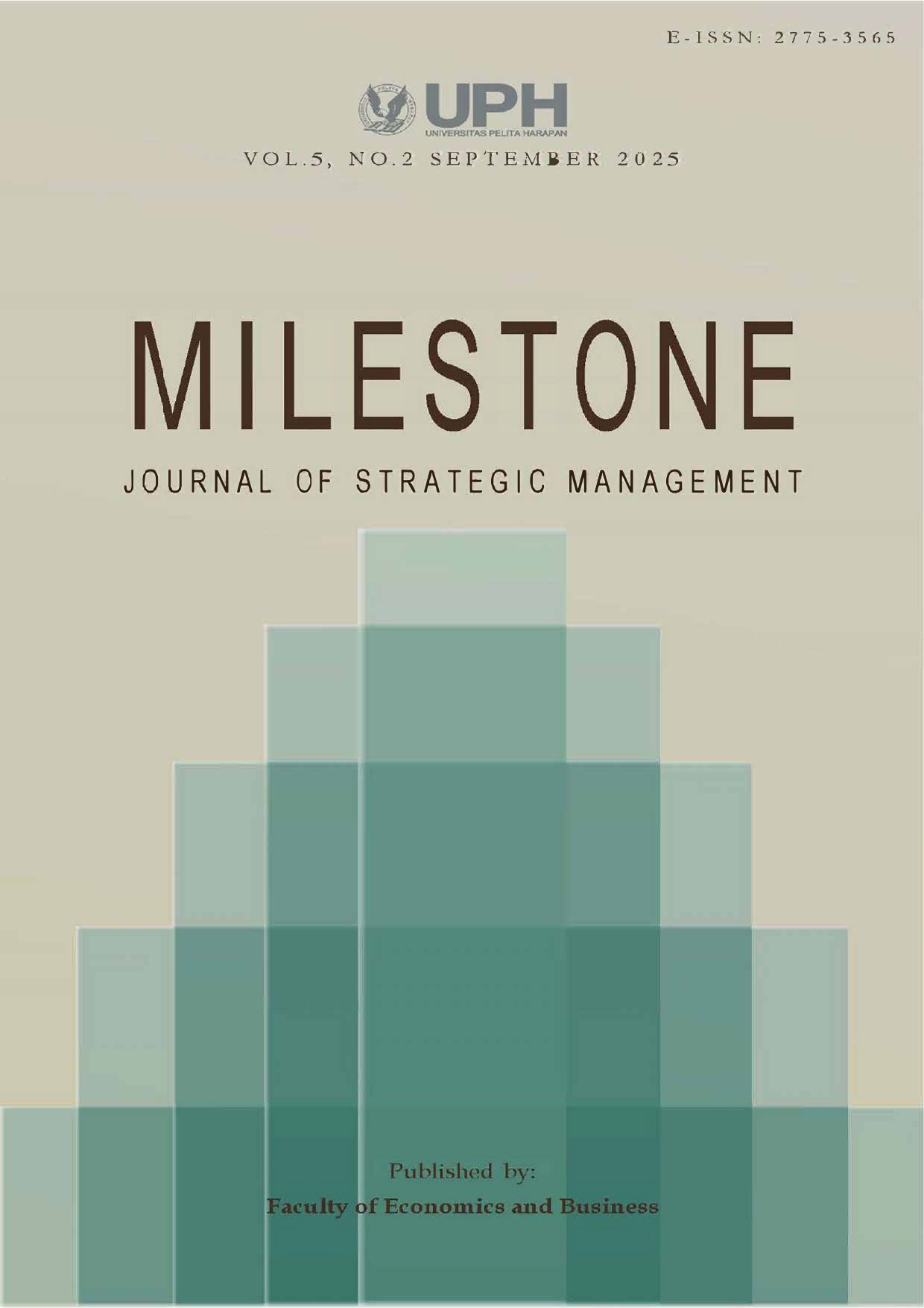The Competitive Advantage of CCC in Integrated Services of Construction in Indonesia
DOI:
https://doi.org/10.19166/ms.v5i2.10025Trefwoorden:
Integrated Construction Services, Strategic Management, Competitive Advantages, Differentiated Competitive AdvantagesSamenvatting
In the background of global infrastructure construction and the transformation of the construction industry to an integrated service model, this study draws on strategic management theory, especially Porter's theory of competitive advantage and the resource-based view (RBV), to explore the research questions: 1. What are the strategic factors that contribute to the competitive advantage of CCC? 2. How are the strategic factors applied/implemented to contribute to the competitive advantage of CCC. And draw the competitive advantages of CCC to maintain its leading position in the highly competitive integrated building services field. This study is mainly based on interviews, through qualitative research and literature analysis, to explore the factors that CCC uses to build differentiated competitive advantages. The development of CCC in Indonesia shows that Chinese enterprises should pay attention to the comprehensive balance of technical capabilities, quality control, social responsibility and employee development in the process of "going out" to achieve a high-quality and responsible international development path. The researchers hope that this study can provide some reference for peer companies to enhance their competitive advantages, and at the same time provide strategic inspiration for international customers and other researchers to understand how Chinese integrated building service providers can gain competitive advantages in the evolving global infrastructure ecosystem.
Referenties
Creswell, J. W., & Clark, V. L. P. (2018). Designing and conducting mixed methods research (3rd ed.). Sage.
Financial Times. (2023, March 15). Indonesia’s infrastructure drive attracts Chinese state-owned giants. Financial Times. https://www.ft.com/
Hossain, M. U., Ng, S. T., & Antwi-Afari, M. F. (2022). Digital technologies for achieving sustainable development goals in construction: A review. Journal of Cleaner Production, 356, 13–24.
Islami, X., Mustafa, N., & Latkovikj, M. T. (2020). Linking porter's generic strategies to firm performance. Future Business Journal, 6(1), 1–15. http://dx.doi.org/10.1186/s43093-020-0009-1
Jurevicius, O. (2025, June 16). Competitive advantage. Strategic Management Insight. https://strategicmanagementinsight.com/tools/competitive-advantage/
Knott, P. J. (2022). Is VRIO a bar to entry? Examining the role of VRIO in sustaining a competitive advantage. Journal of Strategy and Management, 15(4), 497–513.
Liu, J. Y., Zhang, R. C., & Li, H. L. (2021). Research on key influencing factors of design-construction integration in EPC projects. Journal of Engineering Management, 35(2), 108–113.
Liu, X., & Liang, Q. (2023). The role of localization strategy in enhancing Chinese contractors’ competitiveness in overseas markets. Engineering, Construction and Architectural Management, 30(9), 3201–3218.
Martek, I. (2022). International construction management: How the global industry reshapes the world. Landon: Routledge. https://doi.org/10.1201/9781003097402
Ogunnusi, M., Omotayo, T., Hamma-Adama, M., Awuzie, B. O., & Egbelakin, T. (2021). Lessons learned from the impact of COVID-19 on the global construction industry. Journal of Engineering, Design and Technology, 20(1), 299–320. https://doi.org/10.1108/JEDT-05-2021-0286
Olanrewaju, A., & Abdul-Aziz, A. R. (2021). Building maintenance processes and practices: An international perspective. Springer Nature.
Rehman, M. S. U., Shafiq, M. T., Ullah, F., & Ahmed, K. (2023). A critical appraisal of traditional methods of construction progress monitoring. Journal of Built Environment Project and Asset Management, 13(3), 830–845. http://dx.doi.org/10.1108/BEPAM-02-2023-0040
Saunders, M., Lewis, P., & Thornhill, A. (2019). Research methods for business students (8th ed.). Pearson Education.
Siman, S., & Nugraha, N. (2024). Comparison of traditional and modern construction methods in civil engineering projects. Journal of Innovative Research in Civil and Environmental Engineering, 1(1), 15–22. https://doi.org/10.70134/ircee.v1i1.43
Pangarkar, N., & Prabhudesai, R. (2024). Using porter’s five forces analysis to drive strategy. Global Business and Organizational Excellence, 43(5), 24–34. https://doi.org/10.1002/joe.22250
Tan, Y., Shen, L., & Yao, H. (2019). Sustainable construction practice and contractors’ competitiveness: A preliminary study. Habitat International, 3(2), 225–230. http://dx.doi.org/10.1016/j.habitatint.2010.09.008
Wang, C., & Li, X. (2024). Belt and road initiative and construction enterprises global competitiveness: Strategic insights. Journal of Infrastructure Policy and Development, 8(1), 101–119.
World Bank. (2020). Indonesia infrastructure sector assessment program (InfraSAP): Building the foundations for sustainable growth. Washington: World Bank Group.
Zhang, X., Skitmore, M., & Peng, Y. (2014). Exploring the challenges to industrialized residential building in China. Habitat International, 41, 176–184. https://doi.org/10.1016/j.habitatint.2013.08.005
Zhao, X., Hwang, B. -G., & Lee, H. N. (2016). Identifying critical leadership styles of project managers for green building projects. International Journal of Construction Management, 20(5), 437–449. http://dx.doi.org/10.1080/15623599.2015.1130602
Zhu, J., & He, Q. (2022). How do state-owned enterprises achieve international competitiveness? Evidence from Chinese construction firms. Journal of International Business Studies, 53(7), 1448–1465.
##submission.downloads##
Gepubliceerd
Nummer
Sectie
Licentie
Copyright (c) 2025 Li Wenjiang

Dit werk wordt verdeeld onder een Naamsvermelding-GelijkDelen 4.0 Internationaal licentie.
Authors who publish with this journal agree to the following terms:
1) Authors retain copyright and grant the journal right of first publication with the work simultaneously licensed under a Creative Commons Attribution License (CC-BY-SA 4.0) that allows others to share the work with an acknowledgement of the work's authorship and initial publication in this journal.
2) Authors are able to enter into separate, additional contractual arrangements for the non-exclusive distribution of the journal's published version of the work (e.g., post it to an institutional repository or publish it in a book), with an acknowledgement of its initial publication in this journal.
3) Authors are permitted and encouraged to post their work online (e.g., in institutional repositories or on their website). The final published PDF should be used and bibliographic details that credit the publication in this journal should be included.





